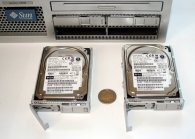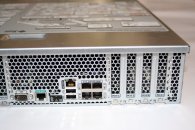Cool threads and hot nerves
Dirk Wetter, Dr. Wetter IT-Consulting
Sun Microsystems – or to be more precise Sun's CEO, Jonathan Schwartz – invited developers and customers to test their systems under Ubuntu and write a report about their experiences.
Because the potential reward for the feedback was tempting and a part of my business is do system consulting/research and wrap it up in technical reports I thought "this seems to fit". There was the choice between Sun's Galaxy (AMD64 CPUs) and the Niagara systems (T1). So I ordered a T1 system through Sun's Try & Buy program a great offer also for customers who are unsure whether the system they have in mind is the right one.
History
Basically the first Linux architectures I used more than 10 years ago for private purposes were not Intel-based (m68k and alpha). However I felt always that the non-Intel architectures were technically not as good as the main i386-line. Out of curiosity I wanted to find out some years back how good the Linux/SPARC port is. IIRC the first try 1997 on an SPARC 10 was the best shot, I tried one year later on an Ultra 5, around 2001 on an E4000 and an E6500 with 28 CPUs. "There was no point" was always my conclusion, "it doesn't buy me anything. Solaris runs great on Sun's SPARC platform, whereas Linux does not." Moreover on Solaris/SPARC in addition to free software there's commercial software from ISVs which will never exist on Linux/SPARC.
June 2006, five years later, Solaris 10 Update 2 hit the road which added an innovative filesystem (ZFS) to Solaris 10 which was in my experience already a good step forward in development. The basis – OpenSolaris, open sourced under CDDL, had in the same month it's first official birthday. Coincidentally also in June 2006, Ubuntu Linux Dapper Drake was released. As the announcement mentions, one of the supported platforms being Linux/SPARC. The UltraSPARC T1 architecture was even certified, whatever that means.
In my five years of Linux/SPARC abstinence I assumed a lot happened and despite the fact that Solaris 10 was there, I thought to give it another try. This is where I started from.
The plan
The plot I outlined was the following: I wanted to run a performance comparison, mainly disk and network I/O, and a variety of application benchmarks, some locally like big compiler jobs and others like LDAP and WWW over the network. The competitors were supposed to be Solaris 10 HW 6/06 on one side and Ubuntu 6.06 LTS on the other side. In addition to that, the plan was to spend some words what from the system administration perspective each operating system is doing good and what could be done better. During my career I spent enough time with both Linux and Solaris in data centers, so this would be the cherry on top.
Test lab
The test environment is basically as in all other cases e.g. for
the Linux
enterprise tests: There's a switched Gigabit network, a Gigabit
router, a DHCP server handing out
fixed IP addresses and network settings, a central syslog server. For
this test worth to mention that in the lab is a ready-to-go jumpstart
environment: a jumpstart server – an old
but for this purpose still useful Ultra 10 – which is replying to
RARP requests, a boot parameter (rpc.bootparamd), TFTP and NFS server, so that
classical installations with just boot net work. In addition
the boot net:dhcp-method is handled by the DHCP server above
who is also serving boot images via TFTP. An odd thing which is worth
to mention upfront: The DHCP/TFTP server machine runs Suse Linux which
comes with tftp-hpa ("hpa" are the initials of the author). This
TFTP server doesn't work with any Sun OBP I have tested so far if you
use boot net. It just loads
the image and bails out which others experienced, too. The Linux-based TFTP server
is in this case only responsible for providing images to Sun machines
started with boot net:dhcp.
Additionally a Sun Blade 1000 was available. But before I tell
here what this was used for and spoil the story, bear with me.
The hardware
There was also the idea to compare Linux and Solaris on Sun's
Galaxy platform. I decided however that this would have been less
fun: On AMD64 systems Linux runs well, Solaris x64 I would
very much suppose, too. I like challenges and since this appeared
to me too much of an easy goer my choice fell on the UltraSPARC
platform.
The T2000 which came to me had the following specs (prtdiag):

- 8 core (32 threads) 1.0 GHz UltraSPARC T1 processor, 1 FPU
- 8 GB memory
- 2×2.5'' inch SAS drives (see picture)
- 4 (!) Gigabit Ethernet ports (10/100/1000)

- a TTYA port (DB9)
- a serial console (RJ45)
- an Ethernet console
- 3×low profile PCIe slots (width each max x8)
- 2×low profile PCI-X slots (64Bit wide)
- 2 redundant PSUs, hotpluggable
and 4 USB 1.1 ports, 2 in the front, 2 in the back (why not USB 2.0?). Overall the impression was/is: a niece piece of hardware! Apart from the data center features mentioned above if you have to swap parts: Service informations are on the top cover, you can easily remove it without a screw driver. The same applies for swapping one of the three fans in the front. And no loose cables anywhere. Not only that service is made easy, it's also just great to look at it. On the inner side of the top cover there are even instructions of a more tougher nature: how to remove the motherboard, the SAS backplane and several other boards.
In the the lab everything was hooked up accordingly – the
serial console to a console server, one of the PSUs to a baytech powerstrip, the first
Ethernet port (NET0) to the GE switch, the Ethernet console to a switch in the management network.
Switching it on for the first time was no big deal. Except maybe
the fact that for customers who are not familiar to Sun's ALOM and
expect the system just to boot
after connecting the power cords and switching it on, information
in the accompanying Getting started Guide would be useful. In fact one has
to connect first to the serial console (SC serial mgmt port), from there one
has to setup the system controller (SC) first. It is a separate computer running
VxWorks, on top of it Sun's ALOM (Advanced Lights Out Manager). After assigning
a password to the SC, you can power-on and boot the rest of the T2000.
There's even a simple check for the quality of
the password! While running setupsc e.g.
you should assign also network settings to the Ethernet console (SC net mgmt port)
and setup notifications.